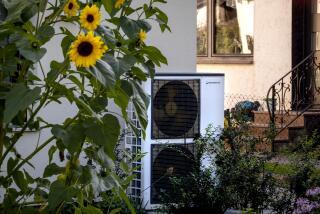Clean-energy lender Renovate America tops $1 billion in loans

Limits on water use because of
A leading clean-energy lender has topped $1 billion in loans for home improvements — a milestone for the San Diego company as well as a once-foundering government program to encourage projects that reduce electricity or water use.
Renovate America got into the business in 2011 as the Property Assessed Clean Energy financing program, or Pace, was struggling to overcome opposition from mortgage lenders and federal housing regulators that had stalled the clean-energy lending effort. Since then, the lender has provided money to 44,000 households for efficiency projects in partnership with local governments using the Pace program.
That represents not only a fast-growing source of revenue for Renovate America but also a gauge of the improving health of Pace programs.
PaceNow, a nonprofit organization that tracks use of the Pace programs nationwide, lists Renovate America as the top operation of lender among more than 100 members. Renovate America is the only one to reach $1 billion in financing, with more than 90% market share of all Pace programs, which operate in conjunction with local governments in 32 states and the District of Columbia.
“American residential energy efficiency is at a tipping point,” said Renovate America Chief Executive J.P. McNeill. “Pace financing is accelerating the adoption of renewable energy, energy efficiency and water efficiency in the housing sector.”
The Pace program finances 100% of efficiency improvements such as new heating and cooling systems and solar power, requiring no upfront cash outlay. The term of the financing is based on the useful life of the product, up to 20 years, which can lower monthly payments.
The payments are collected through regular property tax payments.
The products installed must meet federal and state efficiency standards, enabling homeowners to lower monthly utility bills and help pay for the cost of the improvements over time.
Each year, more than 20 million of the 135 million homes in the U.S. will have systems replaced that affect energy or water consumption — such as air conditioners, heaters, windows, roofs and water heaters — in most cases because existing products are failing, according to Renovate America.
But Renovate America says most homeowners select the least-efficient replacement because they aren’t sure how long they’ll stay in their homes. Although cheaper initially, the inefficient choice can become the most expensive when energy or water costs are factored into the total cost of ownership, the company says.
Although about a third of the $1 billion has gone to solar projects, the most popular lately have been projects to reduce water consumption because of California’s long drought. Since April 1, when Gov. Jerry Brown ordered sharp reductions in water use, Renovate America has seen a surge in water conservation projects.
Limits on water use because of the drought prompted Los Angeles resident Rick Young to purchase artificial turf in July through the Pace financing program at Renovate America.
“I was using a lot of good water,” said Young, a 61-year-old sales representative. “My wife heard on TV about the program and told me to check it out.... This was nothing directly out of pocket immediately and nothing to pay until next year.”
Renovate America says the $1-billion loan milestone represents less than one-half of 1% of the homes in California that could participate in the Pace program.
Pace could get a boost from recent actions at the federal level.
In August, President Obama named Pace as an innovative tool to meet the country’s clean energy and energy-efficiency goals and encouraged its use. In conjunction, the Federal Housing Administration, which insures 1 in 5 new mortgages, announced it is developing guidance for the use of Pace financing, which will help overcome lender resistance that has hobbled the program.
Some have criticized the Pace program for making it difficult to sell a home or refinance a mortgage because the loan is attached to the property as a tax assessment, which gets repaid first before the mortgage.
Severn Williams of Public Good PR, a public relations firm working on behalf of Renovate America, said about 55% of homeowners who use the Pace program pay off the tax assessment before they sell their homes, as they would with a line of credit.
Renovate America has been working with mortgage lenders to make it easier to transfer the assessment, he said.
The projects financed through Renovate America’s financing program are projected to save $2 billion on energy bills, conserve 6.7 billion kilowatt hours of electricity, reduce emissions by 1.8 million tons (the equivalent of taking 347,000 sport utility vehicles off the road for a year), and save more than 2.1 billion gallons of water (the equivalent of 68 million showers), Renovate America said.
The financing effort, which the company calls the Home Energy Renovation Opportunity program, has created more than 8,400 jobs and helped boost the economy by more than $1.7 billion, Renovate America said.
Twitter: @ivanlpenn







